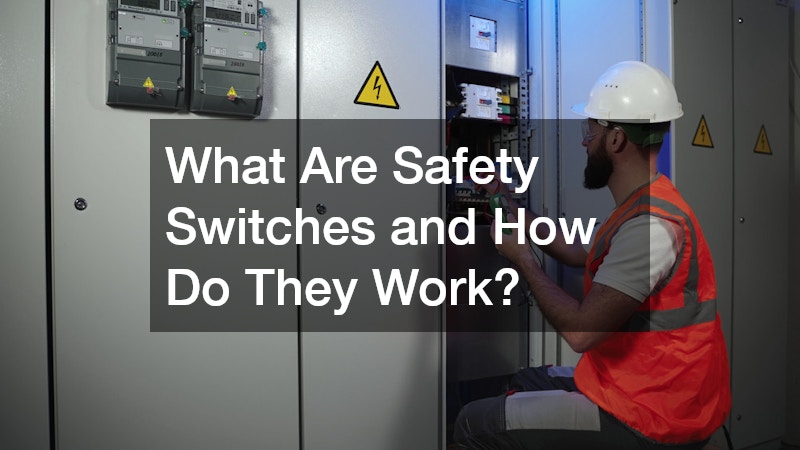In today’s world, electrical safety in homes and workplaces is paramount. One of the most effective devices for protecting people from electric shock and fire caused by faulty appliances or wiring is the safety switch. Often confused with circuit breakers or fuses, safety switches perform a unique and vital role in maintaining electrical safety. Understanding what these devices are, how they function and why they are crucial can empower property owners to make informed choices about their electrical systems.
Understanding the Role of Safety Switches
Safety switches, also known as residual current devices (RCDs), are designed to prevent serious electric shocks by cutting the power supply when they detect an imbalance in the electrical current. Their primary function is to monitor the flow of electricity through a circuit. If they detect that electricity is leaking to the ground, such as through a person who has accidentally touched a live wire, they shut off the power in a fraction of a second.
Unlike circuit breakers, which protect electrical circuits from overload or short-circuiting, safety switches are specifically designed to protect people from harm. This distinction makes them an essential component of any modern electrical system. In Australia, safety switches are mandatory on power and lighting circuits in new homes and regulations continue to expand their required use in other scenarios.
How Safety Switches Operate
The operation of safety switches is based on detecting discrepancies between the current flowing into and out of a circuit. In a properly functioning electrical system, the current flowing to an appliance through the active wire should be equal to the current returning through the neutral wire. If there is even a slight variation—typically 30 milliamps or more—the safety switch interprets this as leakage, which could be through a person or another unintended path and shuts down the power immediately.
This rapid response, often within 0.03 seconds, is critical in preventing severe electric shocks or fatalities. The effectiveness of safety switches relies on their correct installation and regular testing. Most models include a test button that users should activate monthly to ensure the switch trips as it should. Failure to do so could result in a false sense of security, leaving a home or business vulnerable to unseen electrical hazards.
Types of Safety Switches Available
There are several types of safety switches to suit different applications. The most common is the switchboard-mounted variety, which protects entire circuits and is typically installed during electrical fit-outs or upgrades. Portable safety switches can be used for added protection when using power tools or appliances outdoors, particularly in areas without a fixed safety switch system. Power point safety switches are integrated directly into wall sockets and offer protection for that specific point and any appliance plugged into it.
Each type has its strengths and choosing the right one often depends on the nature of the environment and the level of protection required. For instance, workplaces that involve heavy-duty equipment and outdoor electrical tools may benefit from multiple layers of protection, including both fixed and portable switches.
Regulatory Requirements in Australia
Australia has some of the most stringent electrical safety regulations in the world. Under national and state-specific laws, safety switches are a legal requirement for all new homes and must be installed on all power and lighting circuits. For older homes, homeowners are strongly encouraged to upgrade their systems to include safety switches, even if not explicitly required by law.
Rental properties also fall under strict legislation. Landlords must ensure that their properties are equipped with functioning safety switches to protect tenants. Failure to comply with these regulations can result in penalties and, more importantly, expose occupants to unnecessary risks.
The increasing emphasis on electrical safety reflects a broader awareness of the dangers posed by electricity when not properly managed. With the proliferation of electrical appliances and devices in everyday life, the need for effective safety measures continues to grow.
The Importance of Regular Maintenance & Testing
Simply having safety switches installed is not enough. Regular testing is critical to ensure they are in good working order. Most switches come with a test button that simulates a fault, prompting the device to trip. This test should be performed monthly. If the switch fails to trip, it indicates a fault in the device or wiring and a licensed electrician should be contacted immediately.
In addition to user-performed tests, periodic professional inspections are also recommended. Electricians can perform more thorough diagnostics and ensure that all electrical systems comply with current standards. These inspections are especially important in older buildings or after renovations that may affect wiring integrity.
A Final Word on Electrical Safety
Safety switches are a cornerstone of modern electrical safety systems. They offer a fast and effective method of preventing electric shocks and reducing the risk of electrical fires. By instantly disconnecting the power in the event of a fault, they provide a critical layer of protection that saves lives and property.
Understanding how safety switches work and adhering to testing and maintenance protocols ensures that this protection remains reliable over time. Whether for residential, commercial or industrial applications, the role of safety switches cannot be overstated. For anyone involved in managing or maintaining property, investing in these devices and staying compliant with safety regulations is both a legal obligation and a moral imperative.



